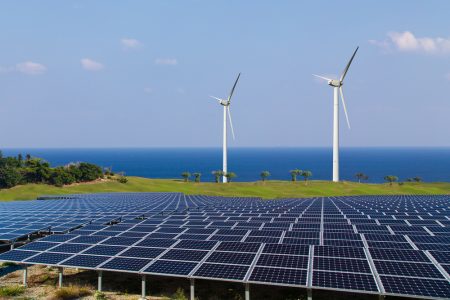Projections See U.S. and Canada Lowering Conventional Energy Use With Distributed Energy Resources on the Rise
Filed under: Energy News
Comments: Comments Off on Projections See U.S. and Canada Lowering Conventional Energy Use With Distributed Energy Resources on the Rise
 DNV GL, a world-leader in quality assurance and risk management services for maritime, oil, gas, power and renewable industries, recently released their annual Energy Transition Outlook for 2019 with projections into the year 2050. This report is DNV GL’s view on the future of energy and what the path ahead most likely will look like. While the United States and Canada are both projected to see an increase in population and wealth, the total energy usage will be lowered by about 30%. Why? An increase in CO2 free electricity by use of Distributed Energy Resources of Solar and Wind.
DNV GL, a world-leader in quality assurance and risk management services for maritime, oil, gas, power and renewable industries, recently released their annual Energy Transition Outlook for 2019 with projections into the year 2050. This report is DNV GL’s view on the future of energy and what the path ahead most likely will look like. While the United States and Canada are both projected to see an increase in population and wealth, the total energy usage will be lowered by about 30%. Why? An increase in CO2 free electricity by use of Distributed Energy Resources of Solar and Wind.
The study shows that by the year 2050, the United States and Canada are both looking at 24% of their total electricity use coming from solar PV. This will be made possible because by the late 2020’s, 962 GWac of solar power will be generated, being installed at a rate of 35 to 45GWac of capacity per year.
Wind turbines will be generating almost 50% of electricity by 2050, with onshore wind climbing to 26% and offshore wind rising to 22% from 0% of today. Hydro and nuclear power, respectively, will be around 8% and gas-fired generation will hover around 10%. Coal, a non-renewable energy resource, will account for about 0% of generation as early as the ‘30’s. This means that by 2050, over 80% of electricity being generated in the United States and Canada will be coming from distributed energy resources.
Seasonal energy storage wasn’t included in the report. The battery storage systems considered were from flow, lithium ion batteries, pumped hydroelectric energy storage and electric vehicles. Standalone systems that use lithium ion batteries deliver only a small amount of energy storage, while electric vehicles (EV) and flow batteries offer greater energy storage services.
In the coming years, DNV GL anticipates that globally, 12 TWac of solar power will be installed, with China leading the pack—being responsible for a little over 4 TWac, while 2 TWac of that capacity will be coming from India (TWac refers to the nominal power output when converted from DC to AC). At this point in time, DNV GL predicts that one-third of global electricity will come from PV. By the ‘30’s, 600 GWac will be installed annually, with solar power making up 60% of all new electricity generating capacity installed each year.
Regional energy usage will still heavily be composed of nonrenewable resources like coal, oil and nuclear fuels in the foreseeable future. But, the CO2 emissions from these nonrenewable sources will slowly begin to decline due to efficiency gains versus the lack of newer, cleaner sources. By 2050, we’re looking at electricity accounting for 45% of total energy used, with 90% coming from CO2 free distributed energy resources.
At Intersect Energy, we provide analysis, financing and structuring of alternative energy solutions to our clients. Our goal is to reduce your site’s environmental impact while helping to maximize your savings. Our distributed energy resources including solar, wind, cogeneration, CHP and fuel cells help save an average of 20% in energy cost to our clients. Lower your conventional energy usage by trusting in the experts at Intersect Energy for all your green energy needs! To keep up with all the latest news in renewable energy, make sure to follow us on LinkedIn.